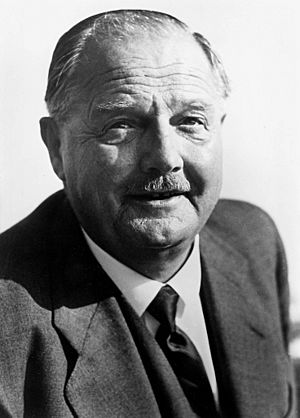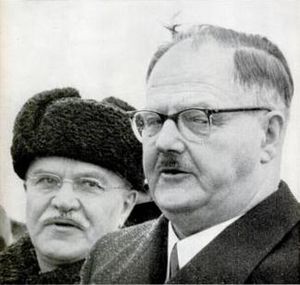Julius Raab facts for kids
Quick facts for kids
Julius Raab
|
|
|---|---|

Raab in 1961
|
|
| Chancellor of Austria | |
| In office 2 April 1953 – 11 April 1961 |
|
| President | Theodor Körner Adolf Schärf |
| Vice-Chancellor | Adolf Schärf Bruno Pittermann |
| Preceded by | Leopold Figl |
| Succeeded by | Alfons Gorbach |
| President of the Federal Chamber of Commerce | |
| In office 26 May 1961 – 8 January 1964 |
|
| Preceded by | Franz Dworak |
| Succeeded by | Rudolf Sallinger |
| In office 10 December 1946 – 18 April 1953 |
|
| Preceded by | Office established |
| Succeeded by | Franz Dworak |
| Minister for Public Buildings, Economic Transition and Reconstruction | |
| In office 27 April 1945 – 20 December 1945 |
|
| Chancellor | Karl Renner |
| Preceded by | Office established |
| Succeeded by | Office abolished |
| Minister of Commerce and Transport | |
| In office 16 February 1938 – 11 March 1938 |
|
| Chancellor | Kurt Schuschnigg |
| Preceded by | Wilhelm Taucher |
| Succeeded by | Hans Fischböck |
| Personal details | |
| Born | 29 November 1891 Sankt Pölten, Lower Austria, Austria |
| Died | 8 January 1964 (aged 72) Vienna |
| Political party | People's Party (1945–1964) |
| Other political affiliations |
Christian Social Party (1927–1934) Fatherland's Front (1934–1938) |
| Alma mater | Vienna University of Technology |
| Profession | Civil engineer |
Julius Raab (born November 29, 1891 – died January 8, 1964) was an important Austrian politician. He served as the leader of Austria, known as the Federal Chancellor of Austria, from 1953 to 1961.
Raab played a key role in making Austria independent again after World War II. At that time, Austria was occupied by different Allied countries. He successfully negotiated and signed the Austrian State Treaty in 1955. This treaty gave Austria its freedom back. In Austria, Raab was known for promoting "social partnership." This meant that different groups, like businesses and workers, worked together for the good of the country. He also supported a "Grand coalition" where major political parties worked together.
Contents
Early Life and Education
Julius Raab was born in Sankt Pölten, a town in Lower Austria. His father was a master builder. He grew up in a middle-class Catholic family.
In 1911, he started studying civil engineering at the Vienna University of Technology. However, he had to pause his studies. He was drafted into the Austro-Hungarian Army during World War I. He fought as a pioneer officer on the Russian and Italian fronts. After the war, he returned to the university.
Starting a Political Career
Raab left university in 1925 to focus on politics. From 1927 to 1934, he was a member of the National Council, which is like Austria's parliament. He represented the Christian Social Party.
He was also involved with right-wing political groups. In 1933, he joined the Fatherland's Front. This was a new right-wing group led by Chancellor Engelbert Dollfuss. During the time known as austrofascism (1934–1938), Raab became more important in the government. Just before Austria was taken over by Nazi Germany in 1938, he became the Minister of Commerce. This takeover was called the Anschluss.
After the Anschluss and World War II
After the Anschluss, Julius Raab lost his position. However, unlike many other Austrian political leaders, he avoided being arrested or killed. This was because a local Nazi leader, whom Raab knew personally, helped him.
Raab was not part of the Austrian resistance movement against the Nazis. But he stayed in touch with other Christian Democrat leaders. He supported his friend Leopold Figl after Figl was released from prison.
In April 1945, after World War II ended, Raab became part of Austria's temporary government. This government was formed in the part of Austria occupied by the Soviet Union. Raab helped create the conservative Austrian People's Party (ÖVP). This new party wanted to move away from the difficult past of the 1930s.
He became the leader of the ÖVP group in parliament after the elections in November 1945. From 1947, he gained more influence. He became the president of the Austrian Federal Economic Chamber. This organization helped manage the "social partnership" between the government, political parties, businesses, and workers' unions. Raab believed in a free market economy with less government control.
Chancellor and Austrian Independence

Julius Raab became the leader of the ÖVP party in 1951. Then, in 1953, he became the Federal Chancellor of Austria. Even though he supported Western countries, Raab built good relationships with the Soviet Union after Joseph Stalin died.
In February 1955, the Soviet Union suggested restarting talks about Austria's independence. On April 12, 1955, Raab, along with Foreign Minister Leopold Figl and State Secretary Bruno Kreisky, went to Moscow for these important talks. These negotiations led to the Austrian State Treaty, which was signed in Vienna on May 15, 1955. This treaty made Austria a free and independent country. Austria also declared itself neutral, meaning it would not take sides in international conflicts.
The success of the 1955 treaty was a major achievement for Raab and his party. Austria also experienced a strong economic growth at this time, known as the Wirtschaftswunder (economic miracle), and had full employment.
In the 1956 elections, Raab's party won a lot of votes, and he remained Chancellor. Raab strongly believed in working closely with the Social Democratic Party, led by Adolf Schärf. In 1957, he helped create the Joint Commission on Wages and Prices. This group became very important for the "social partnership" in Austria.
Later Years and Death
In 1957, Raab had a mild stroke. By the end of the 1950s, his career and his party's influence started to decline. In 1961, he handed over the leadership of the ÖVP to Alfons Gorbach. Gorbach also took over as Federal Chancellor on April 11.
On April 28, 1963, Raab ran for president but lost to the current president, Adolf Schärf. His health quickly got worse. Julius Raab died in Vienna on January 8, 1964, at the age of 72.
See also
 In Spanish: Julius Raab para niños
In Spanish: Julius Raab para niños

